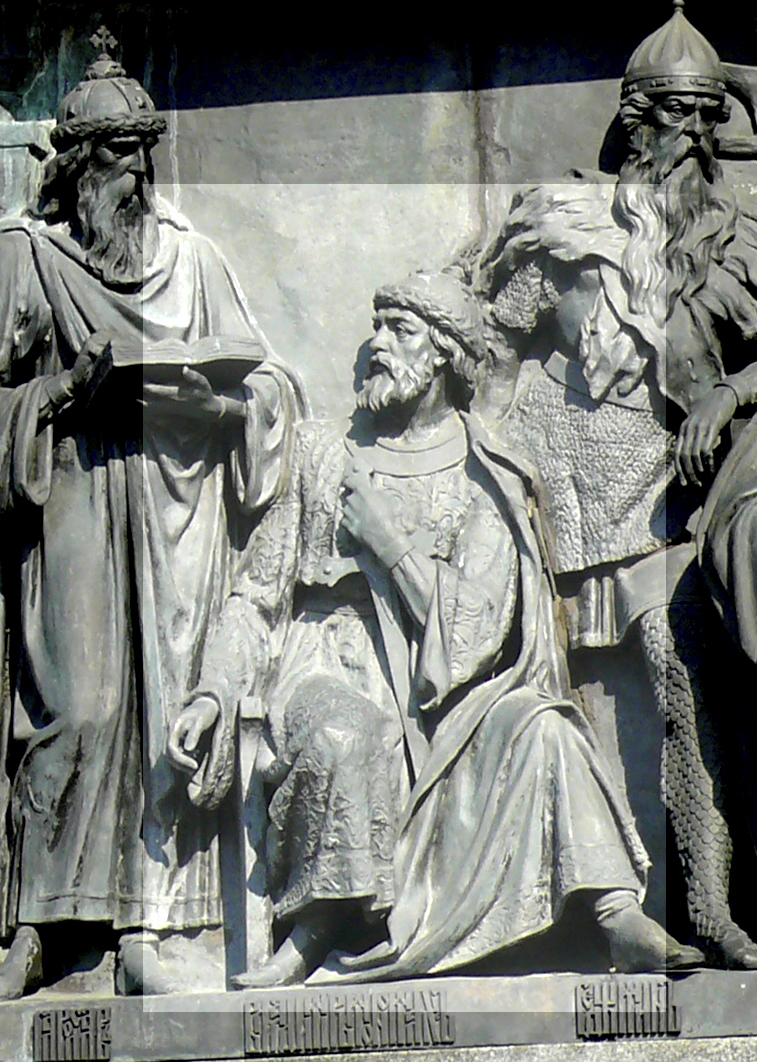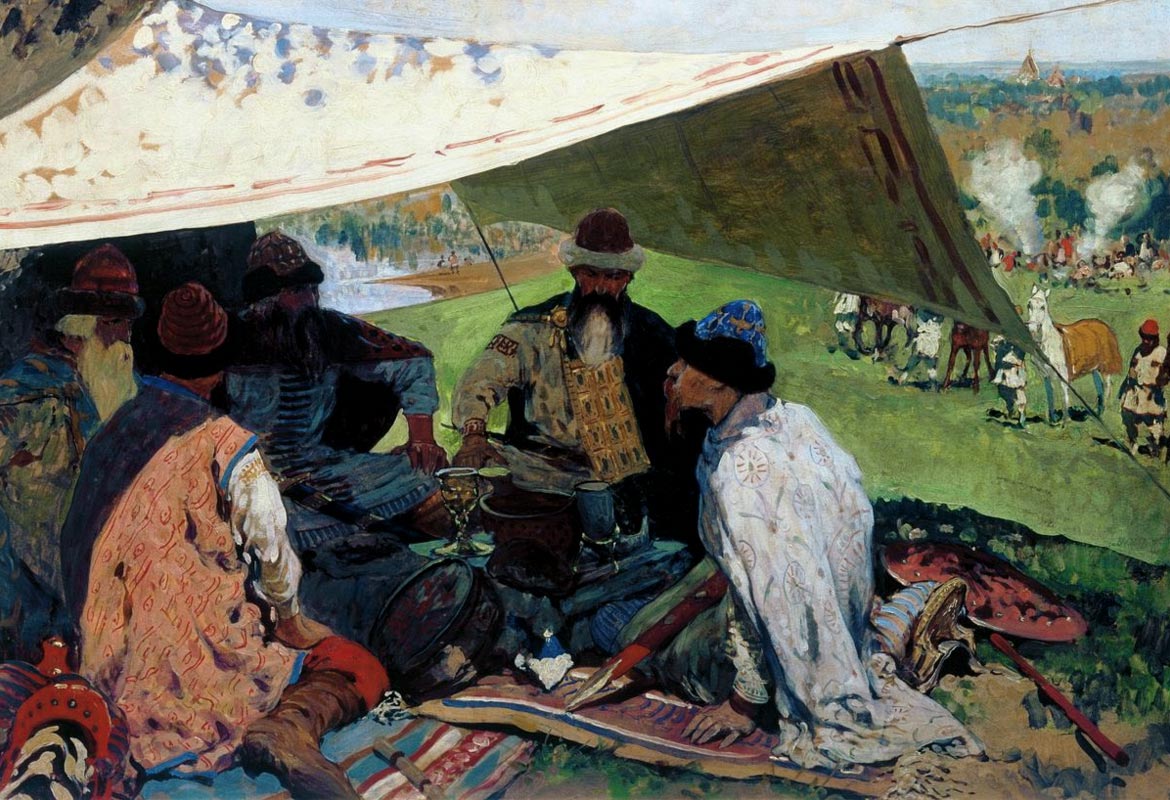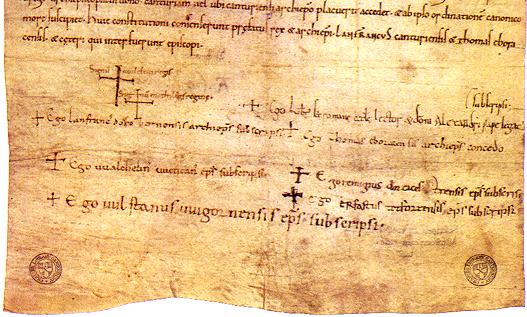|
1093
Year 1093 ( MXCIII) was a common year starting on Saturday (link will display the full calendar) of the Julian calendar. Events By place Europe * April 13 –The Grand Prince of Kiev Vsevolod I Yaroslavich dies, after a 15-year reign. He is succeeded by Sviatopolk II, who is acknowledged by other princes as the senior son of Iziaslav I, and ascends the Kievan throne as ruler of the Kievan Rus'. His cousin Vladimir II, prince of Chernigov, becomes a bitter rival. * May 26 – Battle of the Stugna River: The nomadic Cumans defeat a Kievan joint force led by the princes of Kievan Rus' at the Stuhna River in the valley near Trepol. Rostislav Vsevolodovich, prince of Pereyaslavl, drowns while fleeing the battle. * September 22 – King Olaf III of Norway ("the Peaceful") dies after a 26-year reign. He is succeeded by his son Magnus Barefoot who is proclaimed ruler of Norway at the Borgarting (or the Thing), an assembly of lawspeakers, in the region of Viken ... [...More Info...] [...Related Items...] OR: [Wikipedia] [Google] [Baidu] |
Anselm Of Canterbury
Anselm of Canterbury, OSB (; 1033/4–1109), also called ( it, Anselmo d'Aosta, link=no) after his birthplace and (french: Anselme du Bec, link=no) after his monastery, was an Italian Benedictine monk, abbot, philosopher and theologian of the Catholic Church, who held the office of Archbishop of Canterbury from 1093 to 1109. After his death, he was canonized as a saint; his feast day is 21 April. As archbishop, he defended the church's interests in England amid the Investiture Controversy. For his resistance to the English kings William II and Henry I, he was exiled twice: once from 1097 to 1100 and then from 1105 to 1107. While in exile, he helped guide the Greek bishops of southern Italy to adopt Roman rites at the Council of Bari. He worked for the primacy of Canterbury over the bishops of York and Wales but, though at his death he appeared to have been successful, Pope Paschal II later reversed himself and restored York's independence. Beginning at Be ... [...More Info...] [...Related Items...] OR: [Wikipedia] [Google] [Baidu] |
Magnus Barefoot
Magnus Olafsson (Old Norse: ''Magnús Óláfsson'', Norwegian: ''Magnus Olavsson''; 1073 – 24 August 1103), better known as Magnus Barefoot (Old Norse: ''Magnús berfœttr'', Norwegian: ''Magnus Berrføtt''), was King of Norway (being Magnus III) from 1093 until his death in 1103. His reign was marked by aggressive military campaigns and conquest, particularly in the Norse-dominated parts of the British Isles, where he extended his rule to the Kingdom of the Isles and Dublin. As the only son of King Olaf Kyrre, Magnus was proclaimed king in southeastern Norway shortly after his father's death in 1093. In the north his claim was contested by his cousin, Haakon Magnusson (son of King Magnus Haraldsson), and the two co-ruled uneasily until Haakon's death in 1095. Disgruntled members of the nobility refused to recognise Magnus after his cousin's death, but the insurrection was short-lived. After securing his position domestically, Magnus campaigned around the Irish Sea fro ... [...More Info...] [...Related Items...] OR: [Wikipedia] [Google] [Baidu] |
Vsevolod I Of Kiev
Vsevolod I Yaroslavich (Russian: Всеволод I Ярославич, Ukrainian: Всеволод I Ярославич, Old Norse: Vissivald) (c. 1030 – 13 April 1093), ruled as Grand Prince of Kiev from 1078 until his death. Early life He was the fifth and favourite son of Yaroslav I the Wise by Ingigerd Olafsdottir. He was born around 1030. On his seal from his last years, he was named "Andrei Vsevolodu" in Greek, implying that his baptismal name was Andrew. To back up an armistice signed with the Byzantine Emperor Constantine IX Monomachos in 1046, his father married Vsevolod to a Byzantine princess, who according to tradition was named Anastasia or Maria. That the couple's son Vladimir Monomakh bore the family name of the Byzantine emperor suggests she was a member of his close family, but no contemporary evidence attests to a specific relationship and accounts of the Emperor give him no such daughter. Upon his father's death in 1054, he received in appanage the ... [...More Info...] [...Related Items...] OR: [Wikipedia] [Google] [Baidu] |
Sviatopolk II Of Kiev
Sviatopolk II Iziaslavich ( orv, Свѧтополкъ Изѧславичь; rus, Святополк Изяславич, Svyatopolk Izyaslavich; uk, Святополк Ізяславич; November 8, 1050 – April 16, 1113) was supreme ruler of the Kievan Rus for 20 years, from 1093 to 1113. He was not a popular prince, and his reign was marked by incessant rivalry with his cousin Vladimir Monomakh. Early life Sviatopolk was the son of Iziaslav Iaroslavich by his concubine. Sviatopolk's Christian name was Michael. During his brother Iaropolk's life, Sviatopolk was not regarded as a potential claimant to the throne of Kiev. In 1069 he was sent to Polotsk, a city briefly taken by his father from the local ruler Vseslav, and then he spent ten years (1078–88) ruling Novgorod. Upon his brother's death he succeeded him in Turov, which would remain in possession of his descendants until the 17th century. Reign When Vsevolod Iaroslavich died in 1093, Sviatopolk was acknowledge ... [...More Info...] [...Related Items...] OR: [Wikipedia] [Google] [Baidu] |
Battle Of The Stugna River
The Battle of the Stuhna River (sometimes written as Stugna River; 26 May 1093) was fought between the princes of Kievan Rus', Sviatopolk II of Kiev, Vladimir II Monomakh of Chernigov, and Rostislav Vsevolodovich of Pereyaslavl against the nomadic Cumans. The Kievan forces were defeated. Background The Cumans raided Rus' soon after the death of Vsevolod and sought to buy peace with the new great prince, Sviatopolk. However Sviatopolk incarcerated the Cumans' ambassadors, and the Cumans came in force to attack Kiev. Facing an enemy army of eight thousand, Sviatopolk took the advice of counsel and called for help from Vladimir Monomakh, prince of Chernigov. Vladimir came with his troops and also called upon his only brother, Rostislav of Pereyaslav. Battle A union of Kievan princes against Cumans was achieved, and Sviatopolk released the ambassadors of Cumans. The troops of the three princes joined together and set out for the city of Trepol'. Approaching the Stuhna River, the p ... [...More Info...] [...Related Items...] OR: [Wikipedia] [Google] [Baidu] |
Rostislav Vsevolodovich
Rostislav Vsevolodovich (russian: Ростислав Всеволодович) (c. 1070–1093) was the Prince of Pereyaslavl (1078–1093), son of Vsevolod I of Kiev, and half brother of Vladimir Monomakh. He fought at Stugna river against the Cumans The Cumans (or Kumans), also known as Polovtsians or Polovtsy (plural only, from the Russian language, Russian Exonym and endonym, exonym ), were a Turkic people, Turkic nomadic people comprising the western branch of the Cuman–Kipchak confede ... and drowned while fleeing the battle.Basil Dmytryshyn, ''Medieval Russia: A sourcebook 850-1700'', (Academic International Press, 2000), 60. Notes Rurik dynasty 1070s births 1093 deaths Eastern Orthodox monarchs Princes of Pereyaslavl 11th-century princes in Kievan Rus' {{Ukraine-hist-stub ... [...More Info...] [...Related Items...] OR: [Wikipedia] [Google] [Baidu] |
Lanfranc
Lanfranc, OSB (1005 1010 – 24 May 1089) was a celebrated Italian jurist who renounced his career to become a Benedictine monk at Bec in Normandy. He served successively as prior of Bec Abbey and abbot of St Stephen in Normandy and then as Archbishop of Canterbury in England, following its Conquest by William the Conqueror. He is also variously known as ( it, Lanfranco di Pavia), (french: Lanfranc du Bec), and ( la, Lanfrancus Cantuariensis). Early life Lanfranc was born in the early years of the 11th century at Pavia, where later tradition held that his father, Hanbald, held a rank broadly equivalent to magistrate. He was orphaned at an early age. Lanfranc was trained in the liberal arts, at that time a field in which northern Italy was famous (there is little or no evidence to support the myth that his education included much in the way of Civil Law, and none that links him with Irnerius of Bologna as a pioneer in the renaissance of its study). For unknown reasons ... [...More Info...] [...Related Items...] OR: [Wikipedia] [Google] [Baidu] |
Iziaslav I Of Kiev
Iziaslav Yaroslavich ( orv, Изѧславь Ѩрославичь; russian: Изяслав Ярославич; uk, Ізяслав Ярославич; 1024 – 3 October 1078, baptized as ''Demetrius'') was a Kniaz' ( Prince) of Turov and Grand Prince of Kiev from 1054. Iziaslav's children Yaropolk and Sviatopolk would rule the Turov Principality. Their authority was mainly challenged by the Rostilavichi of Rostislav Vsevolodovich. Biography Iziaslav was the oldest son of Yaroslav I the Wise by his second wife Ingigerd Olafsdottir. Iziaslav succeeded his father, after Yaroslav's oldest child, Vladimir (the only child by Yaroslav's first wife), had predeceased his father. Iziaslav was one of the authors of ''"Pravda Yaroslavichiv"'' – a part of the first legal code of Rus, called Russkaya Pravda. He is also credited with the foundation of the Kiev Pechersk Monastery. Prince Iziaslav I of Kiev ceded the whole mountain to Antonite monks who founded a monastery built by archit ... [...More Info...] [...Related Items...] OR: [Wikipedia] [Google] [Baidu] |
Benedictines
, image = Medalla San Benito.PNG , caption = Design on the obverse side of the Saint Benedict Medal , abbreviation = OSB , formation = , motto = (English: 'Pray and Work') , founder = Benedict of Nursia , founding_location = Subiaco Abbey , type = Catholic religious order , headquarters = Sant'Anselmo all'Aventino , num_members = 6,802 (3,419 priests) as of 2020 , leader_title = Abbot Primate , leader_name = Gregory Polan, OSB , main_organ = Benedictine Confederation , parent_organization = Catholic Church , website = The Benedictines, officially the Order of Saint Benedict ( la, Ordo Sancti Benedicti, abbreviated as OSB), are a monastic religious order of the Catholic Church following the Rule of Saint Benedict. They are also sometimes called the Black Monks, in reference to the colour of their religious habits. They ... [...More Info...] [...Related Items...] OR: [Wikipedia] [Google] [Baidu] |
April 13
Events Pre-1600 *1111 – Henry V is crowned Holy Roman Emperor. * 1204 – Constantinople falls to the Crusaders of the Fourth Crusade, temporarily ending the Byzantine Empire. 1601–1900 *1612 – In one of the epic samurai duels in Japanese history, Miyamoto Musashi defeats Sasaki Kojirō at Funajima island. *1613 – Samuel Argall, having captured Pocahontas in Passapatanzy, Virginia, sets off with her to Jamestown with the intention of exchanging her for English prisoners held by her father. *1699 – The Sikh religion is formalised as the Khalsa – the brotherhood of Warrior-Saintsby Guru Gobind Singh in northern India, in accordance with the Nanakshahi calendar. * 1742 – George Frideric Handel's oratorio ''Messiah'' makes its world premiere in Dublin, Ireland. * 1777 – American Revolutionary War: American forces are ambushed and defeated in the Battle of Bound Brook, New Jersey. * 1829 – The Roman Catholic Relief Act 1829 ... [...More Info...] [...Related Items...] OR: [Wikipedia] [Google] [Baidu] |
Cumans
The Cumans (or Kumans), also known as Polovtsians or Polovtsy (plural only, from the Russian language, Russian Exonym and endonym, exonym ), were a Turkic people, Turkic nomadic people comprising the western branch of the Cuman–Kipchak confederation. After the Mongol invasion of Rus', Mongol invasion (1237), many sought Right of asylum, asylum in the Kingdom of Hungary, as many Cumans had settled in Hungary, the Second Bulgarian Empire playing an important role in the development of the state. Cumans played also an important role in (The Byzantine Empire, the Latin Empire, and the Empire of Nicaea, Nicaea Empire) Anatolia . Related to the Pecheneg, they inhabited a shifting area north of the Black Sea and along the Volga River known as Cumania, from which the Cuman–Kipchaks meddled in the politics of the Caucasus and the Khwarazmian Empire. The Cumans were fierce and formidable nomadic warriors of the Eurasian Steppe who exerted an enduring influence on the medieval Balkans. ... [...More Info...] [...Related Items...] OR: [Wikipedia] [Google] [Baidu] |
Trypillia
Trypillia ( ua , Трипiлля) is a selo in Obukhiv Raion (district) of Kyiv Oblast in central Ukraine, with 2,800 inhabitants (as of 1 January 2005). It belongs to Ukrainka urban hromada, one of the hromadas of Ukraine. Trypillia lies about south from Kyiv on the Dnipro. Trypillia is the site of an ancient mega-settlement dating to 4300–4000 BCE belonging to the Cucuteni-Trypillian culture. Settlements of this culture were as large as 200 hectares. This proto-city is just one of 2440 Cucuteni-Trypillia settlements discovered so far in Moldova and Ukraine. 194 (8%) of these settlements had an area of more than 10 hectares between 5000–2700 BCE and more than 29 settlements had an area in the range 100–450 hectares. History It was near Trypillia that archaeologist Vikentiy Khvoyka discovered an extensive Neolithic site of the Cucuteni-Trypillian culture, one of the major Neolithic-Chalcolithic cultures of eastern Europe. Khvoika reported his findings in 1897 ... [...More Info...] [...Related Items...] OR: [Wikipedia] [Google] [Baidu] |






